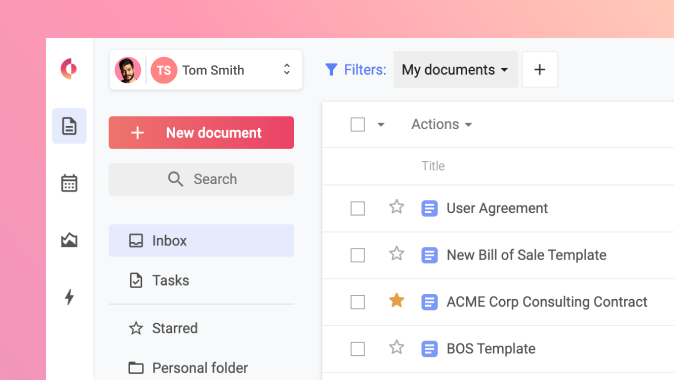This article originally appeared on Business Law Today.
There is a growing divide that separates companies that were “born digital” and legacy organizations struggling to digitally transform woefully archaic processes. Legal professionals play an important role in this digital transformation.
One of the most elemental legal tools—the contract—is a common barrier in a company’s quest to go digital. More specifically, approximately 95% of businesses still manage contracts manually. As a client’s advisor, legal professionals have a choice: perpetuate this outdated workflow or advocate modern practices. The latter path gives them the power to become strategic leaders—both within their firms and in the business world.
The reality is this: many organizations are still stuck using outdated processes and tools. Does emailing a document back and forth and uploading to shared drives sound familiar? Maybe slightly reminiscent of certain current contract management processes? What about walking a contract to an office, or even faxing a signature to a client? Still using two, three, or even more tools throughout the lifecycle of a typical contract is common, and unnecessarily complicates the contracting process.
As stated previously, more than nine out of every 10 businesses still manage their contracts manually. And though it’s widely used and generally accepted, this is not a scalable strategy. Contracts are easily lost, are often scattered making them hard to find, versions are often confused, and workflows are different with every contract. It’s frustrating for all parties involved. More than that, these outdated processes result in lost revenue, missed opportunities, and sometimes hefty compliance fines. Encouraging clients to adopt a cloud-based contract lifecycle management (CLM) platform eliminates these risks and sets them up for greater efficiency and business success.
Managing contracts and creating an efficient, scalable contract management process that delivers value first requires having every document in one place. Then, with organizational best-practices in place, contracts become a source for measurable financial improvements and glean critical insights to organizational performance, while helping teams realize their full potential.
Time is money—a mantra that holds especially true for law firms. But changing a mindset and how an entire team functions can be challenging. A common argument is that it takes more time to learn a new process, or uploading items from legacy systems isn’t an effective use of resources. However, as the pace of business increases, the need for and pace of contract creation grow in parallel. Automating and digitizing these processes are essential for companies to successfully manage their own growth. Even if teams are resistant to a new process in the beginning, with the right solution in place, in a few months’ time they’ll wonder how they ever used anything else.
Contracts are one of the most lucrative resources for a business, yet their full potential remains untapped by most companies simply because they don’t know how to effectively manage them. Contracts are, in essence, gold mines of opportunity—not only for increased revenue, but for a stronger adherence to compliance and operational efficiency.
These gold mines are the top of a funnel that breaks out into three different value-adds—capturing revenue, achieving compliance, and creating efficiency—all of which can be mapped back to growth.
Capturing Revenue
What is a surefire way to get the C-suite’s attention? Numbers, of course. Revenue growth means positive feedback from a board or public investors, and positive exposure for the business. Deals are easily lost whether it’s because of delays, processes, or confusion. Creating an effective strategy mitigates these risks and ensures teams have the right tools to capture more revenue and truly uncap their growth.
Achieving Compliance
How many times has a contract had to be sent back and forth between Legal and other departments, or worse yet, been burdened with a hefty compliance fine after the fact because it wasn’t reviewed at all? If this sounds familiar, a contract management platform is one of the first tools that can significantly impact compliance. Instead of “forgetting” to send a document to Legal or waiting weeks or months for a contract to come back, documents are centralized in one place and easily accessed by multiple different people and teams. Becoming strategic is about setting an example of best practices. Compliance is one of the easiest ways to do this, and one that will be greatly appreciated by a legal team and C-suite alike. Not only does compliance minimize fees, it helps teams work faster. With a thorough knowledge of exactly what’s needed for the proper compliance, teams can focus on strategy and growth, not administrative tasks.
Creating Efficiency
As companies evaluate their processes, operational efficiency should be top of mind. Working faster means more revenue, and if it’s coupled with capabilities that ensure compliance, teams are set up for success. Growth happens not only when teams are working faster, but smarter.
Successfully addressing these three areas eliminates unnecessary blockades and enables companies to realize their full growth potential. Freeing teams lets them actually do their work in a strategic manner and focus on a larger plan.
A CLM solution connects all people, processes and contracts via a single platform, giving a client’s organization everything it needs to manage contracts at every stage—from origination, to negotiation, close and beyond to drive value and automate compliance.
At an organizational level, with a CLM platform in place, compliance can be managed by user roles and permissions. Certain team members need to have more visibility than others. Well-defined user roles and permissions make sure each user has access only to what they need—both in user groups and individual access rights. Creating teams of users streamlines the processes of giving users access and organizing a team. In addition, using the team structure will enable the legal team to automate document management while keeping control over document access.
A contract management platform adds an additional layer of organization by enabling clients to upload documents and use optical character recognition, or OCR. With a powerful search function and every document in one place, an entire contract portfolio can quickly be searched, reported on, and actionable insights can be gleaned, delivering operational efficiency previously unachievable.
Working smarter is a law firm’s obligation to its clients. This means looking back to the past to see what worked, what didn’t, and how to improve. Organizing contracts efficiently and effectively is at the core of every successful business, giving them the ability to uncap growth and become an industry-wide influencer. A contract management platform helps do all this and more. Remaining competitive requires the visibility and wherewithal to make sound decisions and take advantage of opportunities quickly. This is only achievable when all processes, people and documents are in one place. The fastest way to become a strategic contributor and revenue leader is through the power of a contract management platform.



